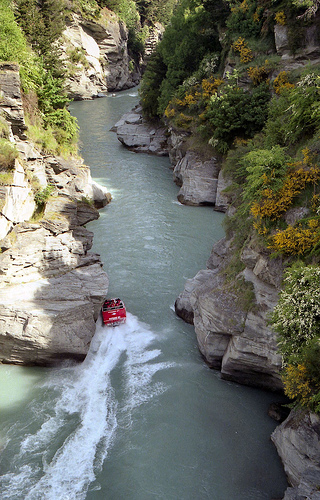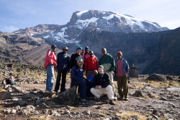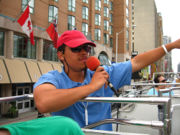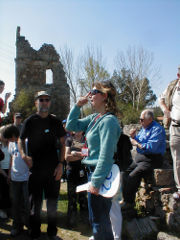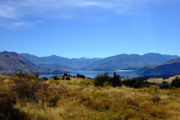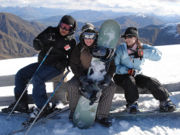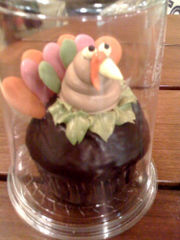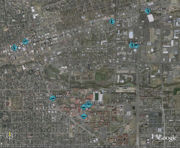Adventure Tourism
| Course Blog |
|---|
Adventure Tourism Course BlogFailed to load RSS feed from http://adventuretourism.wordpress.com/rss.xml|Date|short|max=3: Error fetching URL: Maximum (0) redirects followed |
- Adventure tourism is a type of niche tourism involving exploration or travel to remote areas, where the traveler should expect the unexpected. Adventure tourism is rapidly growing in popularity as tourists seek unusual holidays, different from the typical beach vacation. Mountaineering expeditions, trekking, bungee jumping, rafting and rock climbing are frequently cited as an examples of adventure tourism. Wikipedia 2008
This course will help you to gain relevant experience in the adventure tourism industry that will enable you to design, and guide visitors through a safe, environmentally sustainable and enjoyable adventure tourism activity.
Contents
[hide]Learning Objectives
1. Be able to safely guide visitors through an adventure tourism activity that is longer than one day
2. Design and deliver an appropriate interpretation plan for the tour
3. Have experienced a range of adventure tourism activities on offer to tourists in New Zealand
4. Identify and utilise information and communication technology for tour guiding
Course Schedule
Following is a list of topics we will work through in this course. Each topic has a general introduction, followed by a list of activities to work through, and finally a list of links and resources you might use to work through the activities.
Otago Polytechnic's course weblog will pace you through these topics and put you in touch with teachers, other students and a range of other media and information. Use this schedule as a way to look ahead and prepare in the course.
Orientation and introductions
- Our first topic is to get to know the course, and the people involved in it. If you get lost later in the course, come back to this topic and use the activities to re orientate yourself to things. If you are still lost of confused, make contact with teachers or other students via the course weblog.
To do
1. Download the course calender and save it in your diaries.
2. Attend the first class meeting 21 July in H516 at Otago Polytechnic
Guided tour of more than one day
Our aim is to provide you the student with the relevant skills to design and guide visitors through, a safe, environmentally sustainable and enjoyable guided tour of more than one day.
Kia ora and welcome to what we hope will be a challenging and exciting experience for you. The course will take you from the classroom into the real world of adventure tourism (in this case Wanaka) where you will gain the skills to research, develop and deliver an overnight adventure tour experience. Take a look at this adventure guide sheet put together by students.
You will also have the opportunity to improve your fitness base and try some outdoor pursuits.
The first requirement for you in this course is to understand the components which make up a tour of longer than a day. Here is an overview of your assessment task. What we can do now is design a model by which you can map your research; your audience, the possible choices of accommodation, dining, activities, ideas for your interpretation, and when and how this will be completed. This model will help you determine what will be in your completed itinerary. Just to make sure you have a good understanding of your task we have split the activities between the subject eg. Audience Profile, accommodatin, dining and itinerary - this will be facilitated.
Leadership
Leader or manager - there is a distinction between the two, however many positions/situations within the tourism industry require a person to be both.
What are the skills and qualities required of a tour guide?
Guiding Interpretation
Interpretaion is a communication process, designed to reveal meanings and relationships of our cultural and natural heritage, through involvement with objects, artificats, landscapes and sites." - Interpretation Canada.
Lets renew or refresh your understanding of just what interpretation refers to interpretation. Interpretation as stated is not just about presenting factual information but rather a specific strategy used to translate information for people. Taking the technical and transforming it into everyday language, whilst keeping your audience and yourself, entertained.
Interpretation can also be used to educate - it can outline a company's objectives (refer to your assessment)and encourage environmental and sustainable practice not only for the site but the community incorporating the site - an informed and caring public will not harm a site by littering or vandalism. They often become an advocate for the site supporting local groups when development is threatened.
So lets look a little more closley at interpretation of - the site and how important it is to match the site and your audience in some way.
Another resource you should be familiar with are Tilden's six principles of interpretation which we studied last year.
Finding your own style! Much can be learnt by watching other guides deliver their interpretations. From those who inform us about the natural environment - Akaak Falls, Hawaii. To the costumed interpretation which in this case emphasises theme. Architectual or religious information/interpretation provided to visitors with a particular interest in the subject and the questions that flow on from that.
The interpretation presented by an experienced guide cannot be expected to be duplicated with the same ease in a guide just starting out. Its all about being yourself, letting your personality shine through and of course enjoying what you are doing.
Tips for Interpretation
Choosing a theme - all interpretations are based around a theme or message/s. Its like the plot to a story and it must be uppermost in your mind as you plan your interpretation. Your topic will start as a broad subject and then be narrowed down to a sentence which reflects the essence of what you want to talk about and what kind of message you want to convey.
To assist this these are certain questions you should ask from - does the theme tell an important story and can your visitor/client identify your theme from your interpretation.
Once you have the theme its time to turn your attention to researching. The first step will be brainstorming and clustering. Before you do this however its back to assessing your audience. The better you know your audience the better you can prepare your interpretation. Take a look at the summary of what visitors like: sensory involvement, humour, new information made understandable, and an enthusiastic interpreter.
They do not like: dry lectures, an interpreter that talks too much, an interpretation that is too technical, long and unenthusiastic presentation, or an over enthusiastic one either.
Tips for using humour
Some guides just can't resist trying to entertain but is this humour or ....guide singing.
1. Only use humour to illustrate a point - not just to get a laugh
2. Make sure it is inoffensive and your audience can identify with it - don't embarras your audience
3. It should be unannounced - good humour just drifts in
4. Make sure you are comfortable using it - good timing and delivery is essential
Tour guiding the do's and dont's cleverly wrapped in a lovers disagreement.
Evalutaion and Ongoing Training
If interpretation is an art, perhaps it should be
reviewed, just as plays and paintings are.
- Paraphrased from William J. Lewis
How do you know if your tour was successful? You may have a "feeling" that everything went well. There was good eye contact, enthusiastic participation, questions. These are some methods for evalutating:
- self evaluation sheet
- record yourself either just audio or video
- have someone else observe your presentation - then ask for feedback
- have an expert observe and analyze your presentation
- ask your audience - anonymous suggestion box, written form, ask the audience if the objectives were clear and what did they like most
What you must remember about evaluation is that the feedback should be used constructivley and consistently to assist in improving your skills and not as a negative tool to undermine your confidence.
It may be that your guiding operation had decided to use one of the above methods of evaluation eg. mentoring and has completed this Mentor Checklistat one of your recent tours. Once the evaluation is completed and the results analysed it may be that you require further training.
Attractions and Activities
On this course we would like to take you on a journey which shows not only the wonderful tourism attractions and activities available for visitors to New Zealand (in particular the South Island or Te Wai Ponamu) but also lets you experience a variety of them.
Visitor Attractions
Attractions are one of the key components of the tourism industry adding to the appeal of and often the major reason for visiting the destination. They are very difficult to categorise and definitions differ throughout the world. However, it is important for research and statistics to be able to divide the types of attractions under certain headings. Using the information provided by the Tourism New Zealand website, categorise the lists of New Zealand activities and attractions
Audience Profile
The most important aspect when designing a tour is to consider your audience and their needs and wants. You will be assigned a target audience for your tour and your first job is to establish a profile and a list of possible activities this group might enjoy. In a real life situation prior to a tour, you may have your guests complete a Client Questionnaire. This is a useful way to begin ascertaining a picture of who your guests are and what they want.
Once you have a clearer understanding of your audience you can start matching activities and attractions to what you believe their needs and wants will be. The better you do this the more enjoyable your tour will be and the successful the tour guiding business will become.
Guest's Needs
- Itinerary - your itinerary for the tour has to be comprehensive so your clients are aware of when and where they should be for each attraction and include information about the activity, where they are staying and how they are being transported.
You must also prepare a cost for the holiday you have planned for your target audience ensuring your company is making a profit.
- Accommodation - What kind of accommodation is going to suit your audience?
- Food - Your guests may have particular needs when it comes to food choice or dining needs. You will be planning the meal requirements for their 3 day/2 night tour which will include two breakfasts, three lunches and two dinners. One of the dinner menus will be prepared and served to your group while on your field trip.
Information and communication technology for tour guiding
Over the next few weeks we will explore a range of information technologies that can be useful to a tour guide. From maps and compasses, to blogs and wikis. Information technology is rapidly developing and evolving, and much of it offers a lot of potential to the savey tour guide.Resources and Activities
